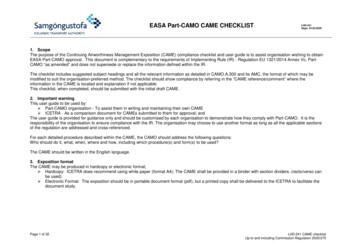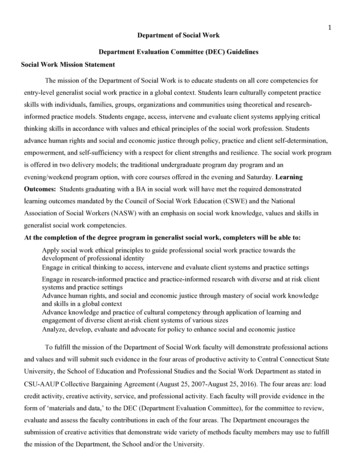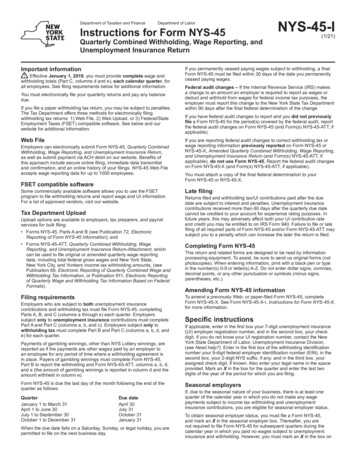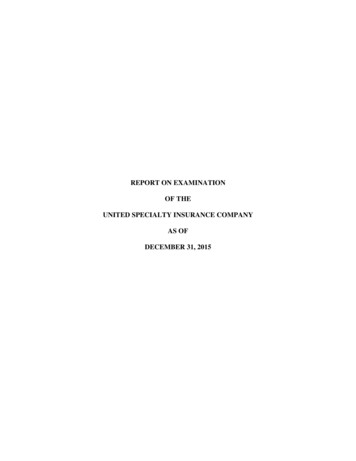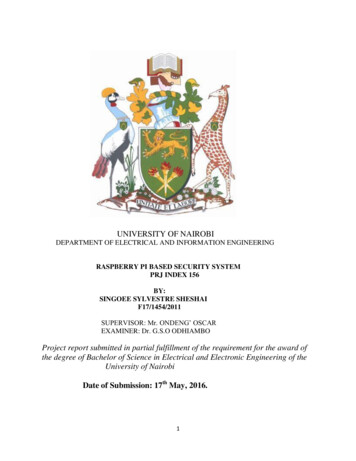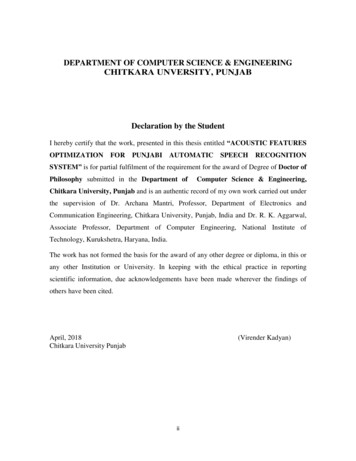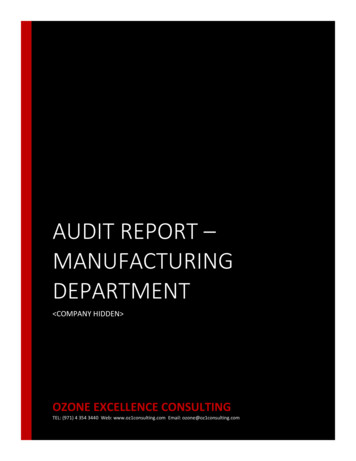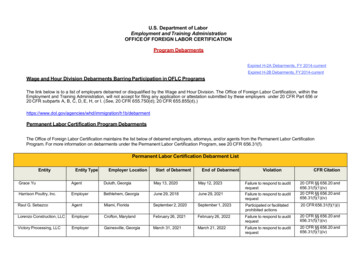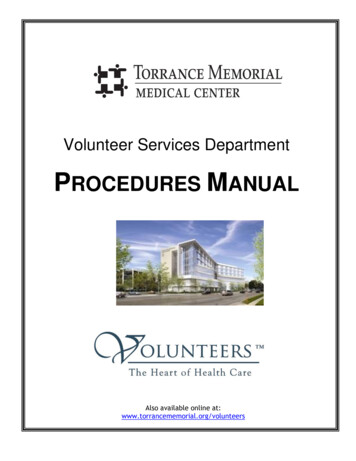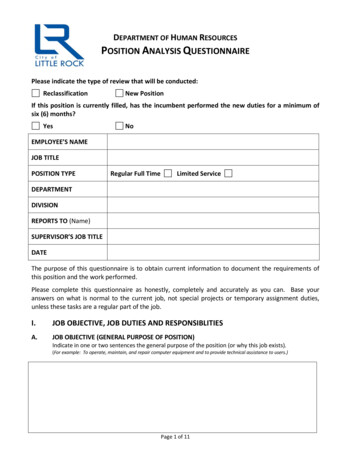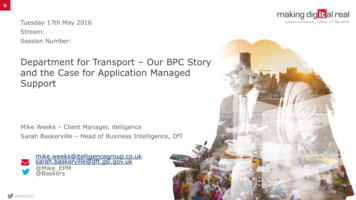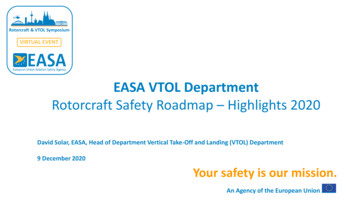
Transcription
Rotorcraft & VTOL SymposiumVIRTUAL EVENTEASA VTOL DepartmentRotorcraft Safety Roadmap – Highlights 2020David Solar, EASA, Head of Department Vertical Take-Off and Landing (VTOL) Department9 December 2020NameTitleYour safety is our mission.An Agency of the European Union
EASA VTOL Webinar2020General updateWelcome by David Solar andgeneral update on thework of his teamRotorcraft SafetyRoadmapThe main deliverables of theRoadmap published this yearand the ongoing activities ofthe Rotorcraft SafetyRoadmap are presented.VTOLpublicationsOverview of what is comingnext and the subject that theagency is working on.2
General update - Looking back at 2020The helicopter community has been instrumental during theCovid19 crisis and delivered servicesThanks to all stakeholers!3
EASA COVID 19 actionsObjective: Anticipate the impact of the COVID-19 crisis on the Aviation Industryand support the Industry in what could be a long recovery phase.Actions: Creation of cross directorate evaluations boards/committees. Including Experts, PCM’s and other staff members.Approving design changes related to cabin conversions, medical evacuation and cargoPublication of a policy (CM) on remote witnessing of certification tests.Publish urgent Safety Information BulletinsPublish guidance material and practical scenarios related to product and design CertificationChanging Implementation RegulationsIssuing exemptions for National Competent AuthoritiesUpdating Safety DirectivesPublication of guidelines – Use of Cargo Tracking devices to support vaccine transportationOther new Health related ActivitiesSupporting Industry bio-secure researchPassenger Locator Form project4
Return to Normal Operations (RNO)Helping DOAs to have helicopter ready for patient transportationDesign changes free of charge up to July 2020Guidance to helicopter cabin installationHelping pilots to return safely to flyingMaking sure that pilots will go back safely to flying was a key objective of the team involved inthe RNO. The Safety promotion team: Michel and John, developed and published guidance,training and videos:Video for pilots Accompanying article and the EASA by GASCo tutorial EASA (Together4Safety) Rotorcraft Community COVID-19 page5
VTOL: major Certification projectsCertified July 2020 – new TCAirbus Helicopters H160New Medium Class RotorcraftCertified June 2020 – DerivativeAirbus Helicopters BK-117 D3 – 5 bladed rotorCertified June 2020 Review of Aviation Safety Issues Arisingfrom the COVID-19 Pandemic NAA support on helicopter specificCOVID-19 installationsLeonardo AW189 KNew Engine version6
20192020CT.3 Vertical Take-Off & Landing Trend in Rotorcraft Rotorcraft sector resistedbetter the COVID-19 crisis However, need to see how2021 will look 82802Jan766Overall 3% open projectOverall FH around -15%832Increase of applications 35% Major Change 23% STC 29% Major Change to STC # project open2766 LAST UPDATE: 06.11.2020FebMarAprMayDeltaOctoberJunJulAugSepOct 3%7
Rotorcraft Safety RoadmapUpdate 2020Covid19 impactImplementationComing nextPresent the reprioritisationand the new activitiesdeveloped to support theindustry in dealing with theCovid19 crisis.The main deliverablespublished this year and theongoing activities.Give a short overview of whatis coming next and the subjectthat the agency is working on.8
Vision and Strategic objectivesEndorsed by EASA and published in Dec 2018Vision:Achieving significant safety improvement for Rotorcraft with a growing and evolving aviation industryStrategic objectives:1.Improve the overall Rotorcraft safety by 50% within the next 10 years.2.Make positive and visible changes to the Rotorcraft safety trends within the next 5 years.3.Develop performance-based and proportionate solutions.1. Number of Rotorcraft accidents in Europe with at least a fatality or a serious injury.2. Additional KPIs based on European Risk Classification Scheme (ERCS).3. Complemented by data collection activity using D4S to built robust accident rates data.9
Roadmap reportRoadmap project plan Project plan, Creation of an Agencyhorizontal project toimplement theserecommendations, Organise the activitiesin Wok-streams, Define for each workstream objectives anddeliverables, Endorsed by EASA inDecember 2018, Contain ambitiousrecommendationsin all domains, Significantcommunication, Actions for allstakeholders.Roadmap ReportStartQ3-Q4 2018 January 2019Mid-term reviewJune 2021TodayFinal reviewDec 202310
Covid 19 and Rotorcraft Safety Roadmap Reprioritisation of the actions toward supporting the industry,Strengthen strategic objective 3 to “Develop performance-based and proportionate solutions”, Cancellation of the all international activities and workshops, Rulemaking Resources re-directed to support the Exemptions and facilitate the continuity ofoperations during the Crisis. EPAS re-prioritisation and RMT delayed. Support the Return to Normal Operations (RNO) project Medium/long term impact on the helicopter operators ?11
Rotorcraft Safety RoadmapUpdate 2020Covid19 impactImplementationComing nextPresent the reprioritisationand the new activitiesdeveloped to support theindustry in dealing with theCovid19 crisis.The main deliverablespublished this year and theongoing activities.Give a short overview of whatis coming next and the subjectthat the agency is working on.12
Work-stream DesignHelicopter Safety Technology Survey A joint survey on the helicopter safety technologies was made together with the International HelicopterSafety Team. 1376 answers were received. The results are available online and are providing inputs for the work-stream on design.Voluntary design improvements Work engaged with the Manufacturers to develop on a voluntary basis product improvements. Net Safety Benefit: The Agency is working on a Certification Memo aiming to facilitate the introduction oftechnologies having safety benefits in the cockpit. It will provide a relaxation of the compliancedemonstration effort for the retrofit of system having safety benefits.13
Main Actions – Example SquirrelCrash Resistant Fuel SystemHydraulic System Certification of 27.952 compliant configuration for AS 350 B3and EC 130,Validation of STC for legacy fleet,Second source bladder certification.Implementation of ambitious Retrofit Plan (EASA SIB 2017018R1).Engine Overspeed Protection Certification of EOP for Arriel 2D and Arriel 2B1 (ref EASA SIB2019-010).Occupant Protection Hydraulic training improvements (EASA SIB2018-013)Dual hydraulic architecture improvement.New TR accumulator.Increase of pressure on single hydraulic(feasibility phase).Other actions Affordable Autopilot STC with yaw control.Alert Systems STC, Main Rotor Strike AlertingSystem.Lightweight Recorders EASA SIB 2019-15R1.Certification of AFT pax seats 27.562 compliant configuration.Certification of pilot seats 27.562 compliant configuration.14
Work-stream Design - Promote Technologies with Safety BenefitsEASA internal strategy paper to Promote Technologies with Safety Benefits onhelicopters and define the approach for toward Net Safety Benefit.1.Introduce proportionality in initial airworthiness certification Part21 light, RMT.0712 Proportionality inCS27.1309, CS-STAN update ongoing2.Review the technologies that are available that may bringoperational safety benefits to helicopters EASA internal review, discussions withsome OEMs, NLR study and IHSF survey3.Promote the voluntary retrofit and installation of systems andequipment having safety benefits EASA article Flight Data Recorders forLight Helicopters, accompanying theEASA SIB 2019 15 R1 Flight Recorders onSmall Rotorcraft.15
Work-Stream on CS modernisation In 2020, the Agency published: Regular update of CS-ETSO: These amendments are expected to reduce the regulatory burden for thevalidation of FAA TSO authorisations by EASA and vice versa, to increase cost-effectiveness ofcompliance demonstrations and to reflect in CS-ETSO the technical state of the art.Update of AMC-20 (amt 19) on aircraft cybersecurityRegular updates of miscellaneous nature (RMT.0457)OPR, AEH (RMT.0643); IFE, occurrence reporting etc (RMT.0561)CS-MMEL / GEN-MMEL, Issue 2CS-MCSD – Maintenance Certifying Staff16
RMTs affecting CS-27/29 (EPAS 21Q3/2021Q4/2021RMT.0128RU CS-27/29CS-27CS-29NPADec-CSRMT.0134RU AMC to CS-27/29CS-27CS-29NPADec-CSRMT.0127 Pilot compartmt viewRMT.0249Recorders installat.RMT.0648CybersecurityRMT.0709R/c hoist issuesRMT.0711CS-27CS-29OPSCS /2022Dec-CSDec-CS CS-27CS-29 CSETSOTOR Critical rotor compts.CS-29TOR RMT.0712R/c safety assessmt.CS-27CS-29RMT.0713R/c human factorsCS-27CS-29RMT.0714R/c fly by c-CS17
RMTs affecting CS-27/29 (EPAS 2020-2024)Q1/2020RMT.0724R/c FCOMRMT.0725R/c oil monitoringRMT.0726 R/c bird ORQ2/2021Q3/2021 CS-27CS-29Q2/2020 Dec-CSNPA18
RMTs affecting Part-26 (EPAS 2020-2024)Q1/2020RMT.0120Helicopter ditchingPart-26CS 26RMT.0710Occupant SurvivabilityPart-26CS-26RMT.0725R/c oil monitoringRMT.0726R/c bird strikePart-26CS-26 ionQ2/2022OpinionTORTORTORQ1/2021NPA NPAOpinionNPATOR NPADec-IRNPA19
Work-Stream on Training safety Creation of the Helicopter Group of NAA Experts (HEG) Start of the work with NAAs on some action of the Roadmap2020: NAA nominated members. Kick-off meeting. Working meeting RMT.196 WP3 to address Virtual Reality Simulators. CS-FSTD(Rotorcraft) and FCS rotorcraft(Helicopter/VTOL/PL) – ToR published and Group Composition completedDeliverable 2020: ToR published. Group nominated. Kick-offheld on 2nd December. Two internal papers on the review of the PPLH provisions and the helicopter instructor certificates havebeen developed and given to the relevant RMT Teams for consideration.Deliverable 2020: Two internal papers based on the outcome of thesurvey to NAAs and ATOs done in 2019.20
Deliverable 2020: NPA to be published in Dec as part of RMT.0678.Revalidation requirement for PPLH pilots.Approach toward introducing regulatory changes: RMT.0678Benefit from ongoing RMTs close to NPA stage to feed “quick-wins” such as re-validation requirement for PPLH,Create a new sub-task in the regular update of FCL to include “a limited number of other non-controversialRMT.0587recommendations stemming for the GA and Rotorcraft Safety Roadmap.To address the Helicopter Instructor Qualification process in the view of simplification and of the introduction of the CBTA RMT.0194concept as an alternate to the traditional process21
Training safety Helicopter Flight Instructor Guide Revision 3 stands for : Re-branding from former EHEST to EASA/Together4Safetypublicationcontent equal to previous EHEST published revision 2 correctingfor typos and editorial inconsistencies, in a format that is easilyadaptable to any form of publishingan invite to further improve the content, i.e. on practical Threatand Error Management - TEM22
Work-Stream - Safety Rating SchemesThe next big concept proposed is the introductionof a voluntary rotorcraft safety rating scheme. Sucha scheme is used in the automotive industry withthe crash test programmes Euro NCAP. It is a goodway to give an incentive for safety improvements totheir vehicles and differentiate themselves (fromthe competition).Extend to environmental criteria?1. Review of Safety Rating Schemes worldwide Survey across the industry of the Safety Rating Schemes availableParticular emphasis on automotive industryReview and compare the Schemes based on a set of defined criteria2. Concept evaluation for a Rotorcraft Safety Rating Scheme Define objectives and aim of a rotorcraft Safety Rating SchemeApply the analysis of the first presentation to suggest a concept3. Initial discussions with the industry on the subject23
Work-Stream on training devices and Simulators Objective: to facilitate and promote the development and use of new innovative and cost-effectivetraining devices. Plan: The regulatory framework for initial (FCL) and recurrent pilot training (OPS) will be adapted. Trainingproviders will first analyse the FCL/OPS regulatory training objectives and then identify the devicerequirements and training tool needs. The identified needs will be subsequently matched with theappropriate training tool available on the market. Ongoing actions: IPC with VR Motion,Support to SC to CS FSTD development (with FOCA),Definition of the training needs,Link between training device capability and training needs.Strongly impacted by Covid-19.24
Work-Stream - Safety Promotion1. Rotorcraft Together4Safety Community Website now launched Material developed through a collaborative approach with industry partners in the ESPN-R 1 Poster, 8 videos, 18 articles and over 400,000 views – we are really starting to reach the community Stand by for the launch of the latest video involving World Rally Champion – Ari Vatanen2. An exciting plan awaits for 2021 Covering a wide range of operational and systemic topics (Hoists, Sling Load, SMS, Flight Instruction)25
Work-stream on simplificationStudy on the Administrative Burden for small helicopter operations: The focus is on helicopter OPS and Aircrew rules,Contract signed, activity started and concluded in Nov 2020,Ecorys and the NLR performed an review of the rules and provisions that impose unnecessaryadministrative burden to small helicopter operators,In-depth interviews with NAAs and small helicopter operators were performed and will providefirst hand information,Proposals for regulatory changes will be analysed into a Best Intervention Strategy.Deliverable 2020: Final Report published.26
Work-stream on simplification Study of the financial size of the helicopter industry. Part of the wider study “Social Indicators Data Collection to Support Impact Assessment, Monitoring and Evaluation Activities(Task 2) “, led by the Impact Assessment Team SM,Final report released in July 2020 but the data are no more directly useful.Deliverable 2020: Final Report. A review of the financing possibility at European-level The EASA Trainees made a review of the funding possibilities at European-level for helicopter operators to implement newsafety systems and equipment.They analysed the current EU funding programmes and interviewed the EASA Research team and the Chief Engineer forguidanceA informal WebEx was organised with company in Brussels specialised in getting EU findings.Deliverable 2020: Paper published. SMS Manual for small helicopter operators. Coming soon.27
Coming next: Helicopter AWOMain feature: Enable helicopter onshore IFR increase the number of available and accessible destination alternates, including the option to use GNSS only atdestination and alternate.Ensure that IFR operating minima and planning minima match the capability of helicopters and are at or below thestandard VFR minima.Reduce VFR minima on a hybrid IFR/VFR flight with PinS VFR departures/approaches.Avoid prohibition of IFR approaches to non-aerodromesProvide additional flexibility for helicopter IFR. Additional features : Use of NVIS for visual segments of an IFR flightUse of EFVS, including operational credit when flying to runwaysModernisation of Offshore approaches: extension to NCC and SPO, and use of OEM designed offshore approachesUpdate regarding coastal aerodromes.28
Coming next: Helicopter training and checking Enables multi-pilot operations of single-pilot certified helicopters on a voluntary basis. Simplifies operations on more than one type or variant of helicopters : SEP and SET groups of types arecreated. The maximum number of types becomes 3 types or groups of types. CAT: Updates checking schemes, CRM assessments and increases the use of simulators Extends the use of CAT alleviations to non-CAT including CAT A to A operations (circular flights) Simplifies aerodrome knowledge requirements for day VFR Introduces a new training and checking scheme for SPO and new AMC and GM for NCC Non-commercial operations: Introduces a policy for the crediting of training delivered by other persons ororganisations. Interface with AWO: Simplifies access to helicopter instrument flight. merger of the SE.IR(H) and ME.IR(H) rating into a single IR(H). crediting of certain FSTD hours towards the instrument flight experience required in CAT IFR single-pilot operations.29
Part 21 Light- OverviewCurrent Part 21Standard TypeCertificate processAircraft intendedprimarily forsports andrecreationalusageEligibilityPart 21 LightTypeCertificateCertificate ofAirworthinessLight CertifiedprocessDeclared processCertificate ofAirworthinessDeclaration ofDesign ComplianceRestrictedCertificate ofAirworthiness30
Key principles of the Part 21 Light Concept Authority involvement is reduced, and is made proportionate to the risk Scoping of Part 21 Light is limited to low risk products, primarilyintended for sports and recreational use Obligation for an organisational approvals are removed A product focussed approach to oversight aims at having a lessbureaucratic system31
A stepped scope of Part 21 Light using risk proportionalityLowest riskPart 21 Light Subpart C: Declared aircraft1. aeroplane with a MTOM of 1 200 kg or less with aseating configuration of maximum 2 persons;2. sailplane or powered sailplane of 1 200 kg MTOM or less;3. balloon designed for maximum 4 persons;4. hot air airship designed for maximum 4 persons.Limited riskPart 21 Light Subpart B: Certified aircraft1. aeroplane with a MTOM of 2 000 kg or less with aseating configuration of maximum 4 persons;2. sailplane or powered sailplane;3. balloon;4. hot air airship designed for more than 4 persons;5. passenger gas airship designed for maximum 4persons6. rotorcraft with a MTOM of 1 200kg or less with aseating configuration of maximum 4 persons.7. Gyroplanes8. Piston engines and fixed pitch propeller on (1-7)32
Developing a Part 21 LightDesign & Production for Sports & Recreational aviationStatus:Finalising the focussed consultation of the new concept & draft rule (4th workshop 19/11/2020)Next step is Advisory Bodies consultation of the draft opinion (2021/Q1)Following stakeholders request and BRprovisions, the Agency is developingthese Objective, risk proportionate rules,stimulating entry into the EU marketusing the “declaration tool” from the BR33
Rotorcraft Safety Roadmap ProgressOn-goingCompletedUpdates(despite COVID impact)Introduce an industry ledRotorcraft Safety ratingscheme.Schemes studies completedNext – Definition of criteriaIdentify the technologiesgranting safety benefitsSIB Flight Data RecordersNRL studyIHSF surveyOEM engagementFinancial support toimplement changes.Coordination with ECEU funding specialistfeedbackMore mandatory & recurrenttraining. Develop the conceptContinued Aviation EducationNAA Helicopter Expert GroupRMT.0678 NPA publicationCreation of RMT.0587 in EPASEffective communication onsafety topics (changebehaviours)Rotorcraft Together4SafetyCommunity Website created1 Poster, 8 videos, 18 articlesand over 400,000 viewsCOVID specific communicationAwareness & reduction ofhigh-risk training scenariosHelicopter Flight InstructorGuide rev 3 publicationModernise the EU pilot trainingsystem & devices (advancetechnologies)R22 VR simulator at EASARMT.0196 WP3 ToR PublishedAlign licensing recurrentrequirements with GARMT.0678 NPA publicationDevelop product safetyimprovement roadmapAll EU products coveredOne US products coveredCovering 80% of the marketEvaluate & address theunnecessary admin. burdenput on operators.Survey publishedNext: Analysis of outcome andproposed integration inRulemaking ProgramEncourage development of cheap new trainingdevices for light & medium rotor.R22 VR simulator at EASA for evaluationRMT.0196 WP3 ToR PublishedCrashworthy fuel tanks and seats.All newly produced EU helicopter fullycompliant (except one – on-going)Approval of STCs for retrofit of existing fleetPart 26 update on-goingFacilitate the introduction of new technology &identify the systems & equipment providingsafety benefitsPart21 light, RMT.0712 Proportionality inCS27.1309, CS-STAN update ongoingCert Memo on Net Safety Benefit draftedProject team & industry tomodernise CSsSignificant activities – ref. EPAS2020-202534
Hybrid and electrical VTOLUpdate 2020MoC Package 1Published last year during theRotorcraft and VTOLSymposiumMoC Package 2TodayComing next 35
Hybrid and electrical VTOL COVID Impact on eVTOL Access to resourcesNumber of projects in development still highFunding May become more difficult Will probably limit the number of new projects Will probably induce a consolidation of robust projects36
VTOL: major Certification PublicationsPublished Jan. 2020Published May 2020Published May. 2020Presented Dec. 20201400 registrationsDec. 9th liveSC Hybrid/ElectricPropulsion SystemseVTOL MoC – Phase 1SC Gyroplane – Roadvehicle useeVTOL MoC – Phase 2CRD under consolidation37
VTOL, - Coming Next Final publication of SC Hybrid and Electrical propulsion and associated CRDFinal publication of MoC phase 1 and associated CRDPublication for comment of MoC Phase 2Work on MoC phase 3 for next SymposiumPublication of EUROCAE Standards 23 standards publication planned in 2021!Significant Industry and EASA effort38
Certification Directorate UpdateBackgroundNew OrganisationWhat’s nextWhat were the main drivers?Present the new CertificationorganogramMain challenges ahead39
CT Adjust purposeManagement of Expert resourcesSynergiesAchieve critical size of expert resources per product lineExpand synergies between GA and VTOLLean organisational structurePoliciesReduce overhead & Protect technical resourcesReinforce the management of policy developmentKnowledge ManagementDevelop knowledge management initiatives40
Adjustedorganisation41
Thank you for your attentionFeel free to submit your questions on our live event platform .easa.europa.eu/connectYour safety is our mission.An Agency of the European Union
RMT.xxxxStrategic taskToRTerms of ReferenceRMT.xxxxImportant taskNPANotice of Proposed AmendmentRMT.xxxxStandard taskA-NPAAdvanced Notice of Proposed AmendmentRMT.xxxxRegular update taskABCAdvisory Body ConsultationHarmonisation with bilateral partnersDec-CSDecision re Certification SpecificationDelivery completedDec-AMCDecision re Means of Compliance to IRDelivery postponedDec-IRDecision pending adoption of Implementing RuleTechnical work completed, delivery aheadOpinionProposal to European CommissionUse of Art. 15 or Art. 16 procedureDec/OCombined Decision (CS or AMC) & OpinionPublication delayedRURegular Update Publication pendingCancelledCurrent position on timeline
Design Improvement internal project - MethodsECCAIRSSquirrel Safety StudyOrganized data for HumanFactor/Pilot Awareness andAircraft HandlingFishbone diagramBowtie diagramEvent Risk ClassificationtoolsSelected ExpertisemethodsMultidisciplinary teamCT ExpertsFS ExpertsSM ExpertsDesk reviewCollaborative brainstormingALARPDesk Review of occurrences followed by collaborative brainstorming sessions for identification of specific contributing factors.Further analysis of problem statements through bowtie diagrams for definition of design barriers.Risk Rating using Event Risk Classification tool.Assessment of proposals for design improvements.Cost-Benefit Analysis using 2-D ALARP (As Long As Reasonably Practical) presentationDecision MatrixFull Analysis Report44
810 831 832 812 786 795 766 779 794 766 782 788 807 803 802 808 777 786 820 . EASA article Flight Data Recorders for Light Helicopters, accompanying the . Create a new sub-task in the regular update of FL
